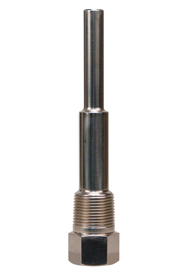-
Home
-
Service
-
Application notes
Thermowells: Protecting Your Temperature Measuring Instrumentation
If your thermometer operates in unfavorable conditions such as corrosive media, physical impact, or higher-pressure gas or liquid, then you need to protect the temperature gauge with a thermowell. In addition to protection, these wells allow you to remove the temperature instrument for replacement, repair, or testing without the need to "open-up" the process.
Thermowells are available in a variety of materials, along with a wide variety of thread or flange fittings depending on your installation requirements.

Selecting a Thermowell
Materials
You should consider the possibility of corrosion when selecting the construction materials of your thermowell. Stainless steel wells provide excellent corrosion resistance, but your media may require you to choose another material such as brass, carbon steel, Monel®, Inconel®, nickel, Hastelloy®, tantalum, titanium, or Teflon® coating.
Connection
You can thread, bolt (to matching flange), clamp, or weld the well in place. While the pipe thread provides mechanical strength, the weld or braze provides the seal.
Flanged thermowells consist of a bar stocks well that is solidly welded to a top quality flange. Standard construction uses a primary "J" groove weld and a bevel groove clean fillet. This double welded construction eliminates the possibility of crevice corrosion, leaving no open joints inside or outside the installation.
Insertion Length
To ensure accuracy, you should immerse the installed element in liquid up to its sensitive length plus one inch – in air or gas, you should submerge the element up to its sensitive length plus three inches. The length of the well inserted into the piping system is called the “U dimension.”
Bore Size
Almost all installations use several types of temperature measuring sensors. Your selection of a standard bore diameter can produce extreme flexibility within the plant. That is, the same thermowell can accommodate thermocouples, resistance thermometers, and bimetal thermometers.
Tapered or Straight Shank
Tapered shank provides greater stiffness than a straight shank with same sensitivity. The higher strength to weight ratio give these wells higher natural frequency than the equivalent length straight shank well, thus permitting operation at higher fluid velocity. You should use the tapered shank for heavy duty applications characterized by high vibration, pressure, temperature, or velocity.
Because you must take many details into consideration when selecting thermowells, WIKA’s technical advisors can help you identify and produce the appropriate well for your specific application requirements. If you would like to perform a wake frequency calculation please visit our website for assistance.
Flanged Thermowell (Solid Machined), Type TW10
Threaded Thermowell (Solid Machined)
Type TW15